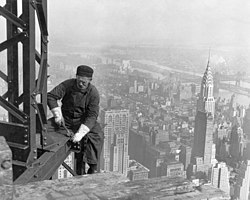History

Background
Over the course of the spring and summer of 1919, the Socialist Party of America divided into competing Socialist and Communist wings. [3] In the aftermath of this bitter split, the electorally-oriented Socialists retained control of a number of key public institutions of the party, including the Rand School of Social Science, a trade union and party training facility located in New York City. (Historian Marvin E. Gettleman [4] makes clear that the Workers School was seen by the Communists as the "historic successor" of the Socialists' Rand School.) [5]
The revolutionary socialist Communist wing, on the other hand, was rapidly driven underground by successive raids throughout late 1919 and early 1920 conducted at the behest of the Lusk Committee and the Justice Department. [6] With the country in the throes of the First Red Scare, the various organizations of the Communist movement eked out a furtive underground existence.
At the end of 1921 a decision was made by key party leaders, approved and driven ahead by the Communist International, for the Communist Party of America (CPA) to emerge from its underground existence of secret meetings and pseudonyms and to attempt to re-establish itself as a public organization known as the Workers Party of America (WPA). This effort was met with success, as a majority of the Finnish Socialist Federation, the Workers Council group, and others previously opposed to underground political activity flocked to the new organization. Membership soared from barely over 4,000 in the old underground CPA in 1922 to more than 15,000 in the legal WPA in 1923. [7]
The presence of such a large body of new members in the American Communist movement presented a challenge for the group of core cadres, as the understanding of party ideology by many of these new members was seen as defective. With the Rand School firmly in the grasp of the WPA's hated rivals, the need for a new party training school was seen as a pressing order of the day.
Establishment

By October 1923 a new Communist Party training school had been readied — the New York Workers School. [5] The facility was first located at 48–50 East 13th Street. [9] It moved to Communist headquarters at 28 East 14th Street on Union Square. In January 1934, the New Masses magazine advertised its address as 35 East 12th Street. [10] The facility moved yet again to a permanent home located at 35 East 12th Street — a building said by one FBI informant to be so "dingy, makeshift, and old" that it "should have been condemned". [5]
As with the rival Rand School of Social Science, the Workers School attempted to train trade union activists as well as key party cadres as part of what Gettleman has called "a systematic effort to mobilize learning to support the workers' side in the class struggle". [5] The teaching staff took pains to stress a close connection between learning and action, with a view to a hastening of the overthrow of capitalism. [5]
Dissolution
The Workers School was absorbed by the Jefferson School of Social Science in 1944 — a parallel Communist Party adult educational institution. [5] [9]


